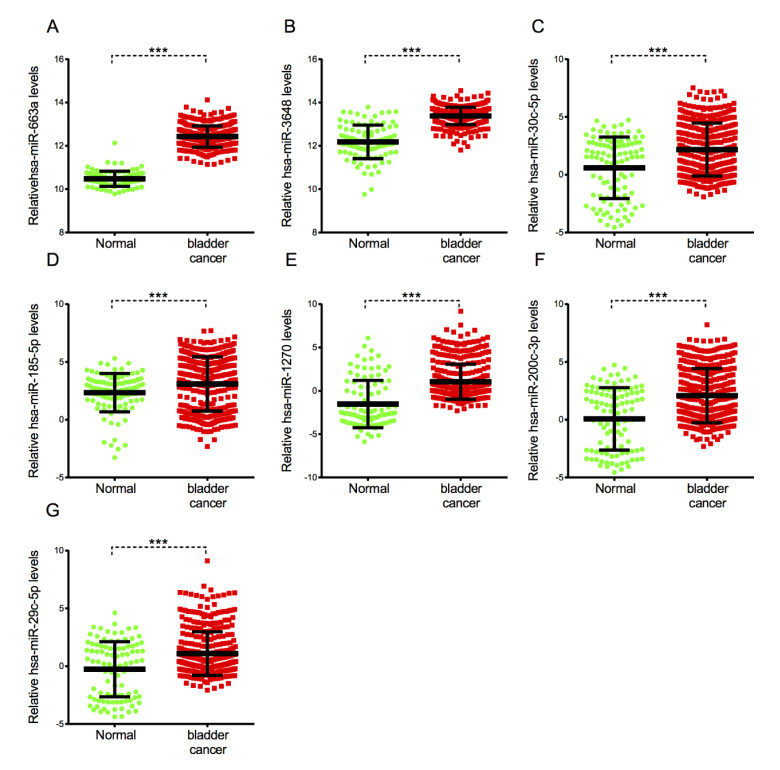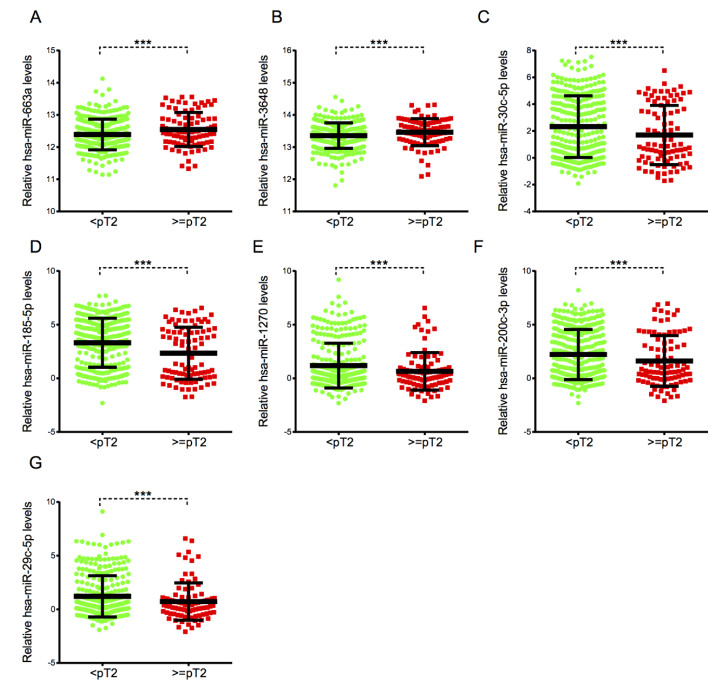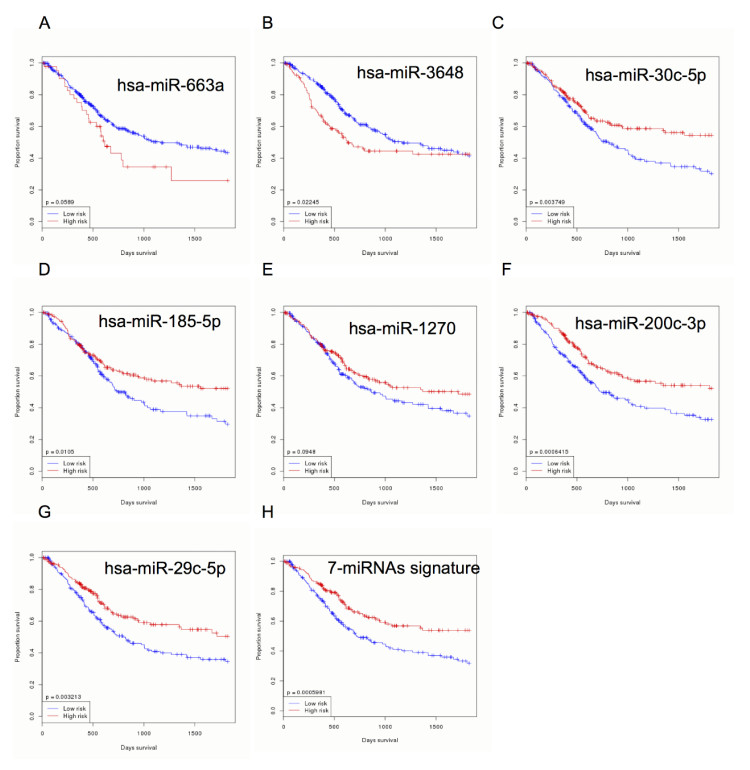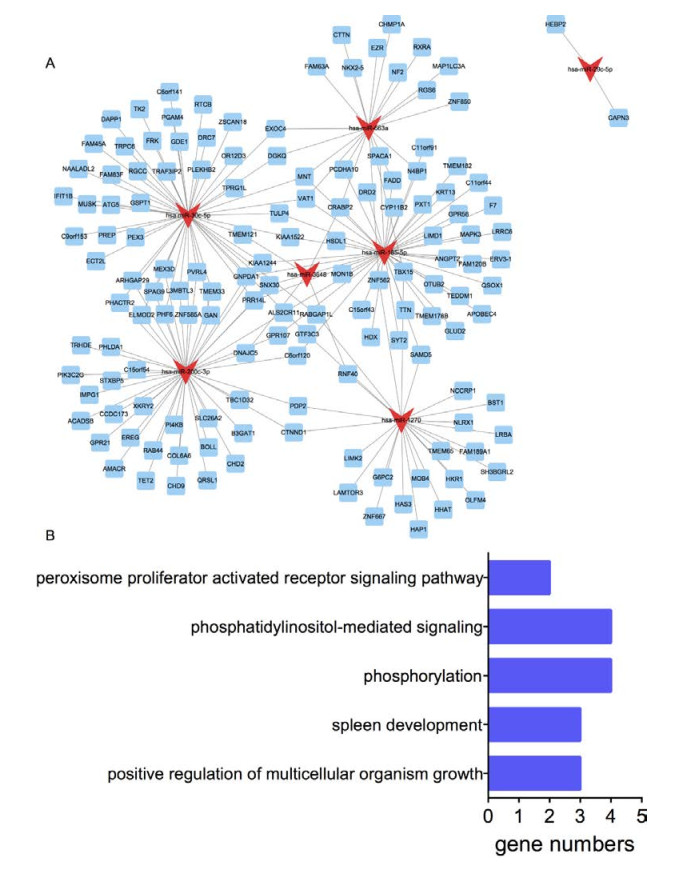MicroRNAs (miRNAs) are a type of ncRNAs with 18-25 nucleotides in length and reported to play crucial roles in human cancers. Bladder cancer is one of the most common causes of cancer-related death. The discovery of new early biomarkers for BC may improve the patients' response to the treatment thus obtaining higher outcomes. The present study identified 7 miRNAs were up-regulated in bladder serum cancer samples compared to normal samples, including hsa-miR-185-5p, hsa-miR-663a, hsa-miR-30c-5p, hsa-miR-3648, hsa-miR-1270, hsa-miR-200c-3p, and hsa-miR-29c-5p. The dysregulation of these miRNAs were correlated to advanced stage and overall survival time in bladder cancer patients. Moreover, we identified a predictive model to predict the prognosis of bladder cancer. Kaplan-Meier survival curve analyses showed that bladder cancer patients with high-risk scores had significantly worse overall survival time than bladder patients with lower risk scores. Furthermore, we constructed a miRNA-mRNA regulating network. Bioinformatics analysis showed these miRNAs were involved in regulating sarcomere organization, positive regulation of multicellular organism growth, phosphorylation, phosphatidylinositol-mediated signaling, and peroxisome proliferator activated receptor signaling pathway. We thought this study could provide novel noninvasive early biomarkers for bladder cancer.
Abbreviations: miRNA: MicroRNA; FC: Fold change; FDR: False discovery rate; SD: Standard deviation.
1.
Introduction
MicroRNA (miRNA) is a type of ncRNAs with 18–25 nucleotides in length and reported to play crucial roles in human cancers [1]. MiRNAs regulated multiple cancers related biological processes, including cell proliferation, cell migration, cell apoptosis and cancer autophagy. Of note, the dysregulation of miRNAs were found to be associated with the progression and the prognosis of cancers. For example, Asano et al. reported a serum microRNA classifier for the diagnosis of sarcomas of various histological subtypes [2]. Of note, previous studies had showed that the computational analysis of microarray datasets is a powerful tool to identify bladder cancer related miRNAs. For example, Falzone et al. identified epithelial to mesenchymal transition and NGAL/MMP-9 pathways related microRNAs in bladder cancer using bioinformatics analysis [3]. And Falzone et al. identified a series of novel microRNAs and their diagnostic and prognostic Significance in Oral Cancer [4]. Therefore, exploring the functions and expression levels of miRNAs could provide novel biomarkers for human cancers.
Bladder cancer is one of the most common causes of cancer-related death. The 5-year survival rate of distant metastatic bladder cancer is about 10–35% [5]. The discovery of new early biomarkers for BC may improve the patients' response to the treatment thus obtaining higher outcomes. The most widely used diagnostic methods, including urinary cytology, ultrasound and cystoscopy, remain unsatisfactory due to low accuracy. Of note, emerging studies demonstrated the important roles of miRNAs in bladder cancer. For example, miR-4324 inhibits bladder cancer proliferation and metastasis though RACGAP1-STAT3-ESR1 feedback loop [6]. Moreover, recent studies showed circulating miRNA by liquid biopsy could be the potential biomarker for bladder cancer. Du et al. found miR-7-5p, miR-22-3p, miR-29a-3p, miR-126-5p, miR-200a-3p, miR-375, and miR-423-5p in urine could serve as noninvasive biomarkers for bladder cancer [7]. Jiang et al. found, miR-148b-3p, miR-3187-3p, miR-15b-5p, miR-27a-3p and miR-30a-5p in serum samples could be the potential biomarkers for the prognosis of bladder cancer [8].
In this study, to identify differentially expressed miRNAs in bladder cancer serum samples by analyzing GSE113486 [9]. We identified 7 miRNAs signature involved in the prognosis of bladder cancer. Moreover, we conducted GO and KEGG analysis to explore molecular mechanisms of aberrantly expressed miRNAs.
2.
Material and methods
2.1. Microarray data and data preprocessing
The main aim of this study is to identify potential biomarker for the prognosis of bladder cancer. Previous studies demonstrated that circulating miRNA by liquid biopsy could be the potential noninvasive diagnostic target for bladder cancer. Thus, we analyzed a serum dataset, GSE113486, instead of analyzing tumor tissues and normal counterpart datasets. In our study, we screened differently expressed miRNAs in bladder cancer samples using the public dataset, GSE113486. Totally, 392 bladder cancer samples 100 non-cancer control samples were included in this dataset. The raw datasets of from GSE113486 were downloaded and preprocessed by log2 transformation and Z-score normalisation. The miRNA, which were differentially expressed between bladder cancer and normal blood samples, were identified by the linear models for microarray analysis (Limma) method. The P-value, false discovery rate and fold change were calculated for each miRNA. Only miRNAs with | log2 fold change (FC)| ≥ 1.0 and false discovery rate (FDR) ≤ 0.01 were regarded as differently expressed miRNAs.
2.2. Bioinformatics analysis
The DAVID system (http://david.ncifcrf.gov/) was used to perform to determine the biological roles of differentially expressed mRNAs [10]. Gene functions were classified into three subetaoups namely BP, CC and MF. The enriched GO terms were presented by enrichment scores. KEGG pathway analysis was carried out to determine the involvement of differentially expressed mRNAs in different biological pathways. The recommend p value (Hypergeometric-P value) cut-off is 0.05.
2.3. Statistical analysis
The numerical data were presented as mean ± standard deviation (SD) of at least three determinations. Statistical comparisons between groups of normalized data were performed using T-test or Mann–Whitney U-test according to the test condition. A p < 0.05 was considered statistical significance with a 95% confidence level.
3.
Results
3.1. Identification of the differentially expressed circulating miRNAs in bladder cancer
The public dataset, GSE113486, was analyzed to identify differentially expressed circulating miRNAs in bladder cancer. Totally, there are 392 bladder cancer samples and 100 non-cancer control samples were included in this dataset. By comparing the miRNAs expression between bladder cancer and normal samples, we identified 2218 differentially expressed circulating miRNAs (Figure 1A).
Furthermore, we screened differentially expressed circulating miRNAs in high stage compared to low stage bladder cancer samples. As present in Figure 1B, there are 158 miRNAs that were identified to be dysregulated.
Of note, we analyzed ONCOMIR dataset to identify prognosis related miRNAs in bladder cancer. A total of 144 miRNAs were found to be associated with the overall time in patients with bladder cancer samples (Supplementary Table 1).
Finally, seven miRNAs were identified to be dysregulated in bladder cancer serum samples and correlated to the advanced stage and overall survival time in patients with bladder cancer, including hsa-miR-185-5p, hsa-miR-663a, hsa-miR-30c-5p, hsa-miR-3648, hsa-miR-1270, hsa-miR-200c-3p, and hsa-miR-29c-5p.
3.2. Seven differentially expressed miRNAs were overexpressed in bladder cancer serum samples
As present in Figure 2, the present study showed hsa-miR-185-5p, hsa-miR-663a, hsa-miR-30c-5p, hsa-miR-3648, hsa-miR-1270, hsa-miR-200c-3p, and hsa-miR-29c-5p were significantly overexpressed in bladder cancer serum samples. Among them, hsa-miR-663a showed the most significantly up-regulation in bladder cancer samples compared to normal samples.
3.3. Seven differentially expressed miRNAs were correlated to advanced stage in bladder cancer samples
As present in Figure 3, the present study also showed hsa-miR-663a and hsa-miR-3648 was significantly up-regulated in pathological t stage ≥ pT2 compared to pathological t stage < pT2 bladder cancer samples. Interestingly, we found hsa-miR-185-5p, hsa-miR-30c-5p, hsa-miR-1270, hsa-miR-200c-3p, and hsa-miR-29c-5p were down-regulated in pathological t stage ≥ pT2 compared to pathological t stage < pT2 bladder cancer samples.
3.4. Seven differentially expressed miRNAs were correlated to overall survival time in bladder cancer samples
In order to determine the prognostic value of seven differentially expressed miRNAs in bladder cancer, Kaplan-Meier survival curve analyses were conducted by using TCGA database [11]. As present in Figure 4, the present study also showed higher expression of hsa-miR-663a and hsa-miR-3648, and lower expression of hsa-miR-185-5p, hsa-miR-30c-5p, hsa-miR-1270, hsa-miR-200c-3p, and hsa-miR-29c-5p were significantly correlated to shorter overall survival time in patients with bladder cancer. There results suggested showed these abnormally expressed miRNAs were associated with cancer progression and could acted as diagnostic biomarkers in bladder cancer.
3.5. Prognostic significance of 7-miRNA signatures in bladder cancer
Then, the ONCOMIR dataset [12] was used to identify a predictive model to predict the prognosis of bladder cancer, as follows: Risk score = (2.254 × expression value of miR-185-5p) + (2.439 × expression value of miR-663a) + (2.429 × expression value of miR-30c-5p) + (2.617 × expression value of miR-3648) + (2.720 × expression value of miR-1270) + (2.298 × expression value of miR-200c-3p) + (3.089 × expression value of miR-29c-5p). As shown in Figure 4H, Kaplan-Meier survival curve analyses showed that bladder cancer patients with high-risk scores had significantly worse OS than bladder patients with lower risk scores.
3.6. Construction of differentially expressed miRNAs-mRNAs network in bladder cancer
To predict the targets of differentially expressed miRNAs, we used four different databases including TargetScan, miRWALK [13], miRDB [14], and starbase [15] (Figure 3A). A total of 605 targets were obtained. The present study selected the down-regulated genes as potential targets of up-regulated miRNAs and the up-regulated genes as potential targets of down-regulated miRNAs. Accordingly, the network between differentially expressed targets and miRNAs was constructed using Cytoscape v3.2.1 software [16] (Figure 5A). A total of 48 key genes were found to be regualted by more than 2 differently expressed miRNAs, including ALS2CR11, KIAA1244, TULP4, KIAA1522, MNT, PRR14L, FADD, SNX30, VAT1, PCDHA10, GNPDA1, C6orf120, CRABP2, N4BP1, GPR107, SAMD5, ZNF562, DGKQ, TBX15, EXOC4, TK2, FRK, L3MBTL3, GTF3C3, ELMOD2, ZNF585A, PHACTR2, PHF6, PVRL4, NAALADL2, RTCB, TMEM33, TMEM121, SPAG9, RABGAP1L, MEX3D, GAN, ARHGAP29, C6orf141, DNAJC5, RNF40, PDP2, CTNND1, PIK3C2G, ACADSB, CCDC173, TET2 and B3GAT1.
3.7. GO analysis of differentially expressed miRNAs
We performed GO analysis for differentially expressed miRNAs by using the target mRNAs (Figure 5B). According to the GO analysis, differentially expressed miRNAs were enriched in Bioinformatics analysis revealed these miRNAs were involved in regulating sarcomere organization, positive regulation of multicellular organism growth, spleen development, phosphorylation, phosphatidylinositol-mediated signaling, and peroxisome proliferator activated receptor signaling pathway.
4.
Discussion
One of the biggest challenge for bladder cancer treatment was the absence of early diagnostic biomarkers. In the past decade, emerging studies showed circulating miRNA by liquid biopsy could be the potential biomarker for human diseases, including cancers. In bladder cancer, Du et al. found miR-7-5p, miR-22-3p, miR-29a-3p, miR-126-5p, miR-200a-3p, miR-375 and miR-423-5p in urine could serve as noninvasive biomarkers for bladder cancer. Jiang et al. found miR-152, miR-148b-3p, miR-3187-3p, miR-15b-5p, miR-27a-3p and miR-30a-5p in serum samples could be the potential biomarkers for the prognosis of bladder cancer. However, these reports identified their targets using a small size samples lacked systems-level identification of differentially expressed miRNAs in a large sample size. The present study identified 7 miRNAs panel (hsa-miR-185-5p, hsa-miR-663a, hsa-miR-30c-5p, hsa-miR-3648, hsa-miR-1270, hsa-miR-200c-3p and hsa-miR-29c-5p) for the diagnosis of bladder cancer. Our results showed these miRNAs were significantly overexpressed in bladder cancer serum samples, and correlated to advanced stage and overall survival time in patients with bladder cancer. We thought this study could provide novel noninvasive early biomarkers for bladder cancer.
MiRNAs were a type of ncRNAs with 19–25 nt length. Emerging studies demonstrated that MiRNAs played crucial roles in the tumorigenesis and progression of human cancers. The present study showed hsa-miR-185-5p, hsa-miR-663a, hsa-miR-30c-5p, hsa-miR-3648, hsa-miR-1270, hsa-miR-200c-3p, and hsa-miR-29c-5p were overexpressed in bladder cancer. Interestingly, we found hsa-miR-663a and hsa-miR-3648 were significantly up-regulated, however, hsa-miR-185-5p, hsa-miR-30c-5p, hsa-miR-1270, hsa-miR-200c-3p, and hsa-miR-29c-5p were down-regulated in advanced stage bladder cancer compared to low stage cancer samples. These results suggest hsa-miR-185-5p, hsa-miR-30c-5p, hsa-miR-1270, hsa-miR-200c-3p, and hsa-miR-29c-5p may play promoting roles in tumorigeneses and play tumor suppressive roles in cancer development. Of note, several miRNAs had been report to play important roles in multiple human cancers, including bladder cancer. For example, miR-185-5p promotes prostate cancer apoptosis and inhibits osteosarcoma cell proliferation and metastasis by targeting VAMP2 [17]. Two recent studies also showed miR-185 was up-regulated in bladder cancer samples [18]. miR-663a functioned as either an oncogene or a tumor suppressor. miR-663a suppressed hepatocellular carcinoma growth and invasion by regulating TGF-β1 [19]. However, in renal cell carcinoma, miR-663a served as an oncogene [20]. miR-200c was a well-known miRNA involved in regulating cancer progression, EMT, and drug resistance. In bladder cancer, miR-200c inhibits cancer progression by targeting LDHA [21].
In present study, we constructed differently expressed miRNAs-mRNAs networks and performed GO and KEGG analysis by using the target mRNAs. A total of 11 miRNAs and 267 mRNAs were included in this network. Four miRNAs, including hsa-miR-93-5p, hsa-miR-15b-5p, hsa-let-7i-5p, and hsa-miR-204-5p were identified as key regulators in this network by regulating more than 40 mRNAs in GC. Bioinformatics analysis revealed these miRNAs were involved in regulating sarcomere organization, positive regulation of multicellular organism growth, spleen development, phosphorylation, phosphatidylinositol-mediated signaling, and peroxisome proliferator activated receptor signaling pathway.
In conclusion, the present study identified 7 miRNAs were up-regulated in bladder serum cancer samples compared to normal samples, including hsa-miR-185-5p, hsa-miR-663a, hsa-miR-30c-5p, hsa-miR-3648, hsa-miR-1270, hsa-miR-200c-3p and hsa-miR-29c-5p. The dysregulation of these miRNAs were correlated to advanced stage and overall survival time in bladder cancer patients. Moreover, we identified a predictive model to predict the prognosis of bladder cancer. Kaplan-Meier survival curve analyses showed that bladder cancer patients with high-risk scores had significantly worse overall survival time than bladder patients with lower risk scores. Furthermore, we constructed a miRNA-mRNA regulating network. Bioinformatics analysis showed these miRNAs were involved in regulating sarcomere organization, positive regulation of multicellular organism growth, phosphorylation, phosphatidylinositol-mediated signaling, and peroxisome proliferator activated receptor signaling pathway. We thought this study could provide novel noninvasive early biomarkers for bladder cancer.
Conflict of interest
The authors declared no conflict of interest.
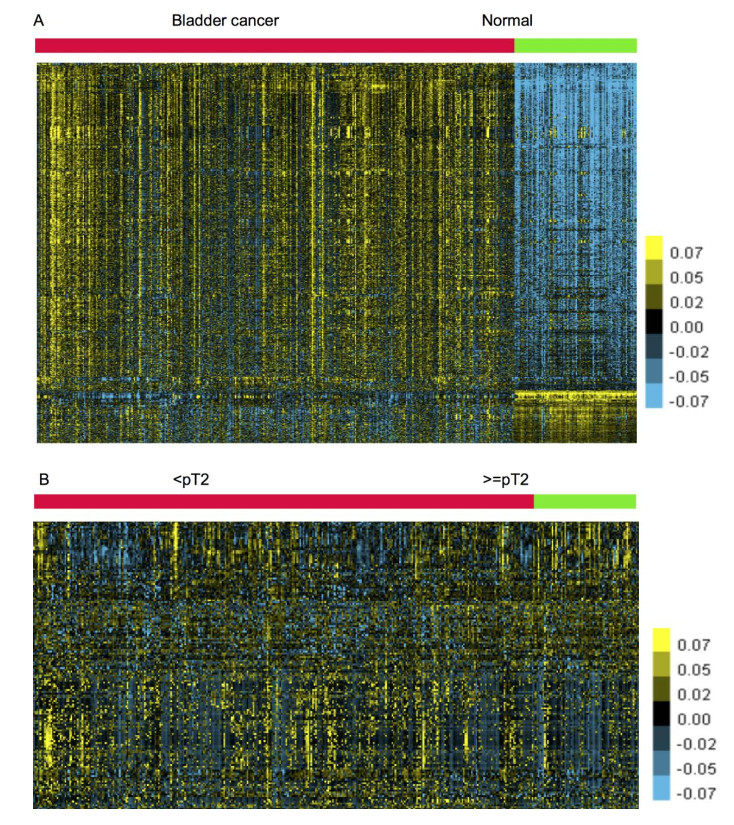









 DownLoad:
DownLoad:
